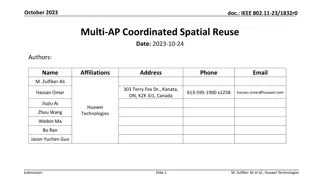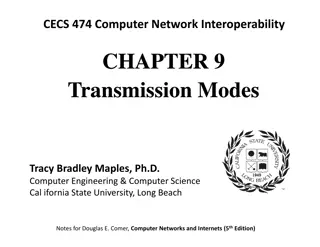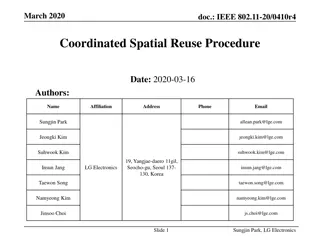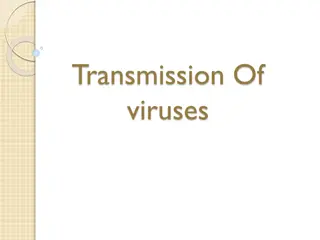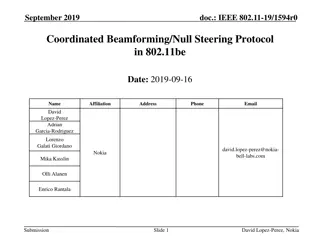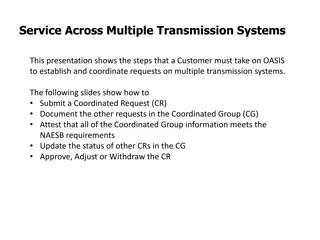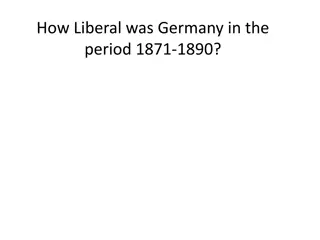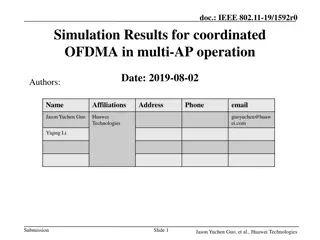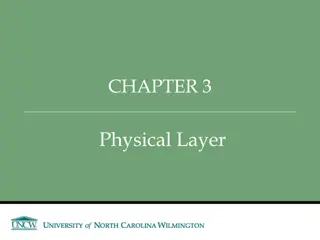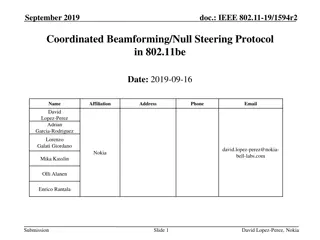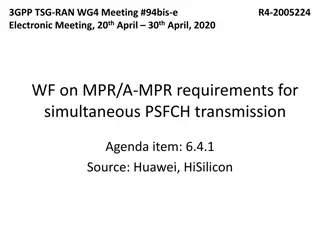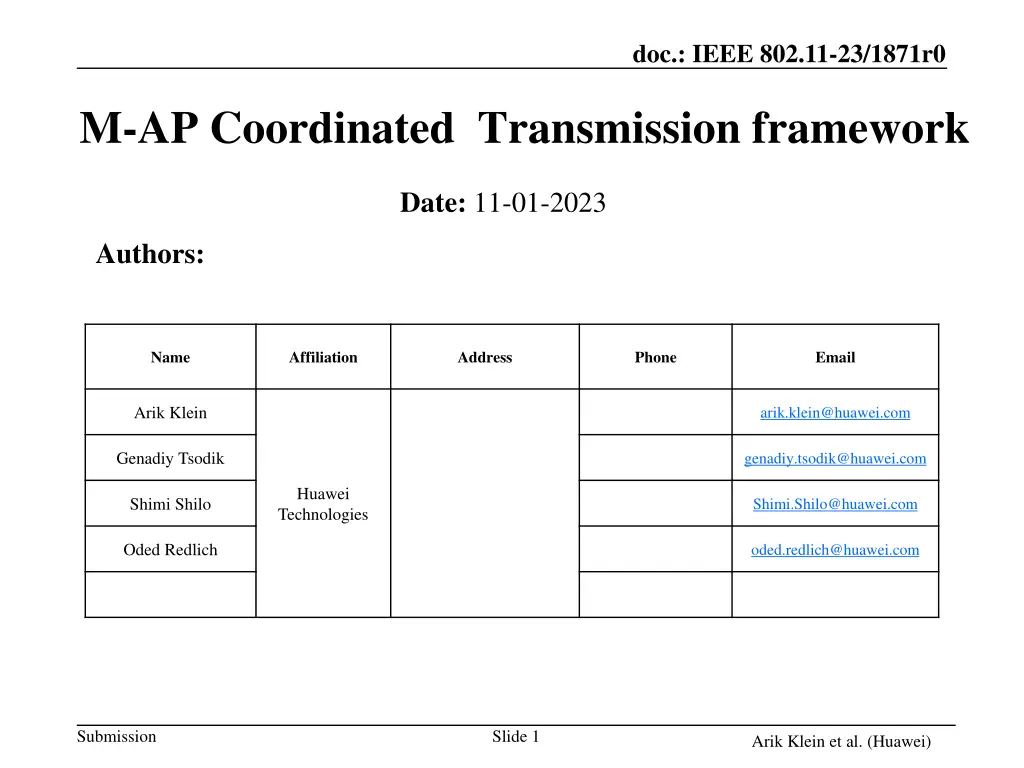
Unified Framework for Multi-AP Coordinated Transmission
Explore the innovative concept of a unified framework for Multi-AP Coordinated Transmission in WLAN networks, enhancing efficiency and throughput by coordinating resources among Overlapping BSSs. Discover the key roles and coordination schemes proposed, along with the essential steps and processes involved in enabling coordinated transmission among APs for optimal performance.
Download Presentation

Please find below an Image/Link to download the presentation.
The content on the website is provided AS IS for your information and personal use only. It may not be sold, licensed, or shared on other websites without obtaining consent from the author. If you encounter any issues during the download, it is possible that the publisher has removed the file from their server.
You are allowed to download the files provided on this website for personal or commercial use, subject to the condition that they are used lawfully. All files are the property of their respective owners.
The content on the website is provided AS IS for your information and personal use only. It may not be sold, licensed, or shared on other websites without obtaining consent from the author.
E N D
Presentation Transcript
doc.: IEEE 802.11-23/1871r0 M-AP Coordinated Transmission framework Date: 11-01-2023 Authors: Name Affiliation Address Phone Email Arik Klein arik.klein@huawei.com Genadiy Tsodik genadiy.tsodik@huawei.com Huawei Technologies Shimi Shilo Shimi.Shilo@huawei.com Oded Redlich oded.redlich@huawei.com Submission Slide 1 Arik Klein et al. (Huawei)
doc.: IEEE 802.11-23/1871r0 Introduction 802.11 UHR SG discussed Multi-AP coordination as a set of features that will yield additional efficiency gain and increased throughput when multiple OBSSs share resources for a coordinated transmission As opposed to current WLAN architecture, where the operation of Overlapping BSSs is not coordinated, thus STAs from different overlapping BSSs might interfere with each other and reduce the total throughput of the WLAN network. The importance of such coordination increases in highly dense WLAN areas where overlapping channels are often used in BSSs with close proximity. The discussions in the UHR SG show high interest in this topic In this contribution we want to share our thoughts on the unified framework for M-AP Coordinated transmission for enabling a modular and efficient coordinated transmission in UHR and beyond. Submission Slide 2 Arik Klein et al. (Huawei)
doc.: IEEE 802.11-23/1871r0 Short Recap In [1] and [2] TGbe agreed on the following two main roles for APs that participate in a coordination [3]: Sharing AP the TXOP holder that shares its resources with other APs Shared APs all the APs allocated with resources for coordinated transmission by the Sharing AP The roles above are dynamic: A single AP is designated as a Sharing AP in a TXOP it obtains and can be designated as a Shared AP in a TXOP obtained by other APs There are several coordination schemes discussed and considered as candidate schemes: Co-TDMA ,Co-OFDMA, Co-SR, Co-BF, JT and Co-UL MU-MIMO [4], [7] [9] Submission Slide 3 Arik Klein et al. (Huawei)
doc.: IEEE 802.11-23/1871r0 Why a unified framework? The M-AP coordinated transmission is the output of a coordination process between a group of APs Capabilities and needs Advertise M-AP Discover other Candidate APs Several preliminary steps are taken by the APs prior to the triggering of the coordinated transmission Initiate proposal for Coordinated transmissions with candidate APs subset Conclude an agreed subset of APs and parameters for coordinated transmission These steps result in a coordinated transmission, where each participant knows when and with which parameters it should operate within its BSS. Optional: Each AP in the agreed subset executes Pre- TX operation within its BSS Sharing AP triggers coordinated transmission Submission Slide 4 Arik Klein et al. (Huawei)
doc.: IEEE 802.11-23/1871r0 Why a unified framework? The coordination scheme only defines the technique being used to share the resources between the participant OBSSs (i.e. Sharing AP and Shared APs) It does not define the exact parameter values that will be used by each participant OBSS It does define a different set of parameters that have to be defined before that coordination scheme is used. Each coordination scheme has its gain vs. complexity tradeoff ,which affects how and when it will be used. A UHR AP may support more than a single coordination scheme. The unified framework defines the various stages the OBSS APs need to take prior to the initiation of a coordinated transmission. This framework includes stages that are common for all the coordination schemes. Submission Slide 5 Arik Klein et al. (Huawei)
doc.: IEEE 802.11-23/1871r0 M-AP coordinated transmission framework The M-AP coordinated transmission includes the following sequential stages: M-AP Discovery M-AP Coordination Agreement setting Pre-Tx M-AP Coordinated transmission M-AP Discovery Coordinated TX agreement Pre TX M-AP Coordinated transmission Submission Slide 6 Arik Klein et al. (Huawei)
doc.: IEEE 802.11-23/1871r0 Stage 1: M-AP Discovery Add a new information element for M-AP Coordination Includes all the parameters and capabilities supported by the AP for the purpose of M-AP coordinated transmission. The element will be received only by UHR APs that support M-AP Coordinated transmission operation. An AP that supports M-AP coordinated transmission can be discovered Passively (i.e. using Beacon frames) or Actively (i.e. sending dedicated management frames among APs, such as: M-AP Probe Request). M-AP Discovery Coordinated TX agreement Pre TX M-AP Coordinated transmission Submission Slide 7 Arik Klein et al. (Huawei)
doc.: IEEE 802.11-23/1871r0 Stage 2: M-AP Coordination agreement setting M-AP coordination agreement: agreement that is established between two or more OBSS APs. This set of APs will participate in the coordinated transmission An M-AP Coordination agreement is required since an AP would agree to become a sharing AP and give up some of the resources in the TXOP it obtains only if there is a guarantee by other APs - that each of these APs will share some of their resources with the AP when it will obtain a TXOP (and will become a sharing AP) M-AP Discovery Coordinated TX agreement Pre TX M-AP Coordinated transmission Submission Slide 8 Arik Klein et al. (Huawei)
doc.: IEEE 802.11-23/1871r0 Stage 3: Pre-TX operation An optional stage that includes operations performed in each BSS prior to the coordinated transmission. These operations may include (but are not limited to): Sequential sounding in Coordinated BF (C-BF) or Joint Transmission (JT) coordination schemes, Switching primary channel in Co-OFDMA coordination scheme etc. If carried out, the Pre-TX operation is required to be executed in the first TXOP obtained by an AP that is a member of the coordination agreement, once an agreement has been established. M-AP Discovery Coordinated TX agreement Pre TX M-AP Coordinated transmission Submission Slide 9 Arik Klein et al. (Huawei)
doc.: IEEE 802.11-23/1871r0 Stage 4: M-AP Coordinated Transmission A coordinated transmission that is triggered by the sharing AP. The number of shared APs and their allocated resources for the current TXOP is defined either: In a predefined assignment included in the coordination agreement Dynamically assigned by the Sharing AP (per TXOP). The Coordinated transmission occurs on a portion of the TXOP obtained by the Sharing AP. M-AP Discovery Coordinated TX agreement Pre TX M-AP Coordinated transmission Submission Slide 10 Arik Klein et al. (Huawei)
doc.: IEEE 802.11-23/1871r0 Summary This contribution presents a unified framework for an M-AP Coordinated transmission. It is common for any M-AP coordinated transmission, regardless of the coordination scheme(s) being used. The proposed framework includes 4 sequential stages: M-AP discovery. Coordination agreement setting Pre-TX BSS operation (an optional stage, relevant for some of the coordination schemes) M-AP Coordinated transmission Need further discussions to refine the unified framework for M-AP coordinated transmission. Submission Slide 11 Arik Klein et al. (Huawei)
doc.: IEEE 802.11-23/1871r0 SP Are you in favor of defining a common framework to support M-AP Coordinated transmission under various coordination schemes? Yes / No / Abstain Submission Slide 12 Arik Klein et al. (Huawei)
doc.: IEEE 802.11-23/1871r0 References [1] 11-20-0566-99-00be-compendium-of-straw-polls-and-potential- changes-to-the-specification-framework-document [2] 11-20-1935-66-00be-compendium-of-straw-polls-and-potential- changes-to-the-specification-framework-document-part-2 [3] 11-20-1895-02-00be-setup-for-multi-ap-coordination [4] 11-20-0560-00-00be-multi-ap-configuration-and-resource-allocation [5] 11-19-1931-02-00be-multi-ap-group-formation-follow-up [6] 11-19-1582-02-00be-coordinated-ap-time-and-frequency-sharing-in-a- transmit-opportunity-in-11be [7] 11-19-1919-03-00be-coordinated-ofdma [8] 11-20-0548-02-00be-discussion-on-coordinated-ul-mu-mimo [9] 11-22-1895-00-00uhr-thoughts_on_map_assumptions Submission Slide 13 Arik Klein et al. (Huawei)

